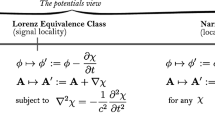Abstract
It is shown that the gauge principle (to be traced back to potential difference) displays a new facet as one approaches the Planck-wall: availability of naked alternatives (symbolized as (—) or (—)), (due to "squeezing" by scaleless regime). Their pairing into binarities (of the type (·, )) is interpreted as an emergence of quanta of information (self-referent qubits to be traced back to the confrontation part-totality inherent to the context of physical measurement). Primordial charges appear through a coating of qubits via stochastic diffusion (blowing up the enclosed information). A geometrical modelization (based on symmetry breaking) is provided, and a principle of logical self-complementation (leading to pairing) is proposed as an asymptote to the gauge principle. The flow of information (interpretable as time-flow), is sourced as a current (shift of mass-units) on the Planck-wall.
Similar content being viewed by others
Bibliography
A. Ashtekar, A. Magnon-Ashtekar, Phys. Rev. Lett. 43, 181 (1979).
A. Magnon, (a) Nonlinear graviton and the problem of mass generation, in press 2000; (b) Int. J. Theor. Phys. 27, 1 (1988).
S. Frittelli, C. Kozameh, E. T. Newman, series of articles in J. Math. Phys. (1995).
A. Magnon, Arrow of Time and Reality: in search of a conciliation, World Scientific, Singapore, 1997.
M. Jacob, in Le temps et sa flêche, Frontiéres Edts, Paris, 1995.
Author information
Authors and Affiliations
Rights and permissions
About this article
Cite this article
Magnon, A. Frontiers of the Gauge Principle and the Unit of Charge. Open Systems & Information Dynamics 7, 179–186 (2000). https://doi.org/10.1023/A:1009626909140
Issue Date:
DOI: https://doi.org/10.1023/A:1009626909140




